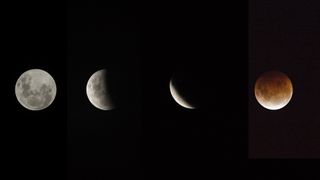Miss the Super Flower Blood Moon this week? Here's when to see the next total lunar eclipse.
If you missed the total lunar eclipse on Wednesday (May 26), you'll have to wait nearly a year for the next one.
Skywatchers in much of the world were treated to a total lunar eclipse on Wednesday (May 26). The spectacle happened to coincide with May's "supermoon" — an informal term to describe a full moon at its closest point to Earth, known as perigee.
During this week's big lunar event, called the "Super Flower Blood Moon," the moon passed directly through Earth's shadow, causing it to appear red for observers in parts of the Americas, as well as eastern Asia, Australia, Antarctica and the Pacific Ocean. While the moon was below the horizon and invisible to the rest of the world, clouds and daylight obscured the view for some prospective observers.
Although there is another lunar eclipse coming up in November, that eclipse won't be a so-called "blood moon," or total lunar eclipse. The next blood moon will occur on May 16, 2022, but it will be another 12 years before a supermoon coincides with another blood moon. Here's how to plan for next year's lunar spectacle.
Video: Super Flower Blood Moon over California in amazing timelapse
Related: Amazing photos of the Super Flower Blood Moon

The total lunar eclipse on May 16, 2022 — the first of two total lunar eclipses in 2022 — will be visible from North and South America, Europe, Africa and parts of Asia. Totality, or the point when Earth's shadow is fully obscuring the moon, will last about 85 minutes, according to Time and Date.
The May 16 total lunar eclipse of 2022 occurs just before the moon reaches perigee on May 17. As a result, the full moon appears to be bigger and brighter than usual — often referred to as a supermoon. Lunar eclipses are also often called "blood moons" because the face of the moon turns red when it passes into Earth's shadow.
Get the Space.com Newsletter
Breaking space news, the latest updates on rocket launches, skywatching events and more!


The second total lunar eclipse of 2022 will occur on Nov. 8. The event will be visible from parts of Asia, Australia, North America, parts of northern and eastern Europe, and most of South America. Totality will last approximately 85 minutes, according to Time and Date.


While the next total lunar eclipse won't occur again until May 16, 2022, there will be a partial lunar eclipse on Nov. 19, 2021, which will be visible from North and South America, Australia and parts of Europe and Asia. The partial lunar eclipse will last about 3 hours and 28 minutes, according to Time and Date.
There will also be two solar eclipses in 2021. An annular, or "ring of fire" solar eclipse, will occur on June 10 and will be visible from North America, Europe and Asia, with Canada, Greenland and Russia to see the best views. A total solar eclipse will occur on Dec. 4, but its total phase will only be visible from Antarctica.


The total lunar eclipse on Wednesday (May 26) represents a rare lunar trifecta, in which a full moon, a supermoon and a total lunar eclipse occurred simultaneously, and was the first in nearly six years.
Skywatchers will have to wait another 12 years to see the next total lunar eclipse supermoon on Oct. 8, 2033, according to NASA and AstroPixels.com, a skywatching site run by retired NASA eclipse expert Fred Espenak.
Editor's Note: If you captured an amazing photo or video of the total lunar eclipse and would like to share it with Space.com's readers, please send your images with comments to spacephotos@space.com.
Follow Samantha Mathewson @Sam_Ashley13. Follow us on Twitter @Spacedotcom and on Facebook.
Join our Space Forums to keep talking space on the latest missions, night sky and more! And if you have a news tip, correction or comment, let us know at: community@space.com.

Samantha Mathewson joined Space.com as an intern in the summer of 2016. She received a B.A. in Journalism and Environmental Science at the University of New Haven, in Connecticut. Previously, her work has been published in Nature World News. When not writing or reading about science, Samantha enjoys traveling to new places and taking photos! You can follow her on Twitter @Sam_Ashley13.